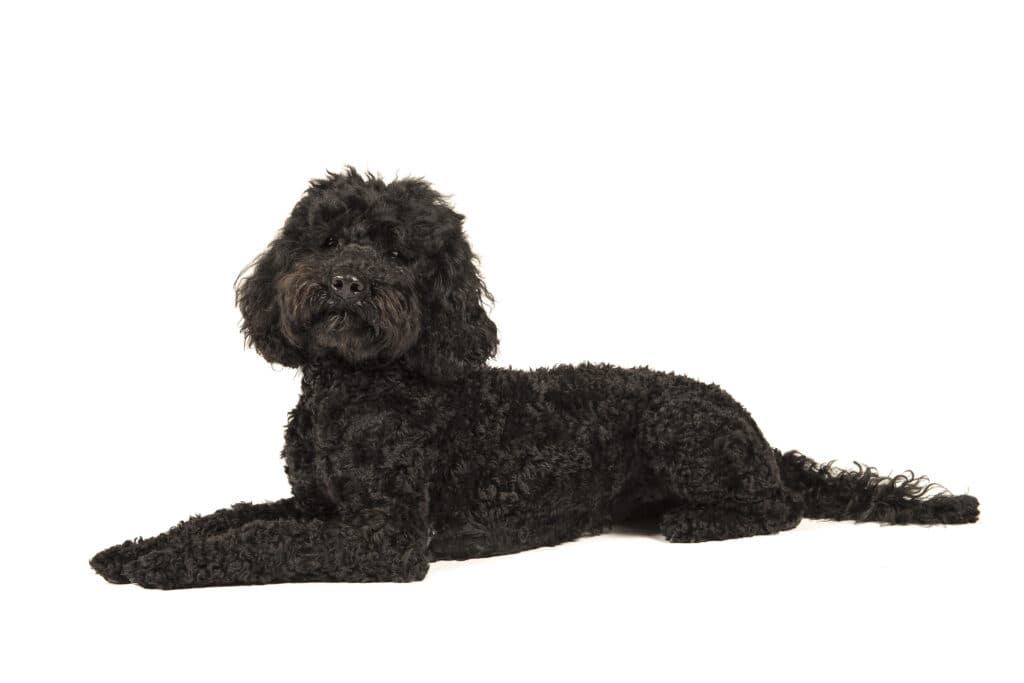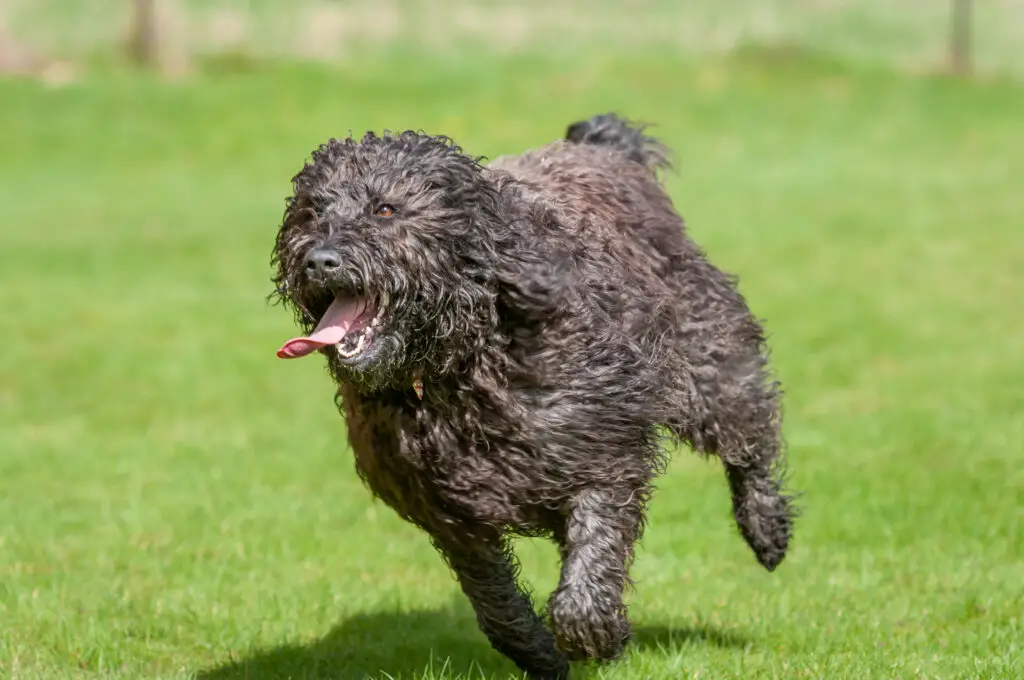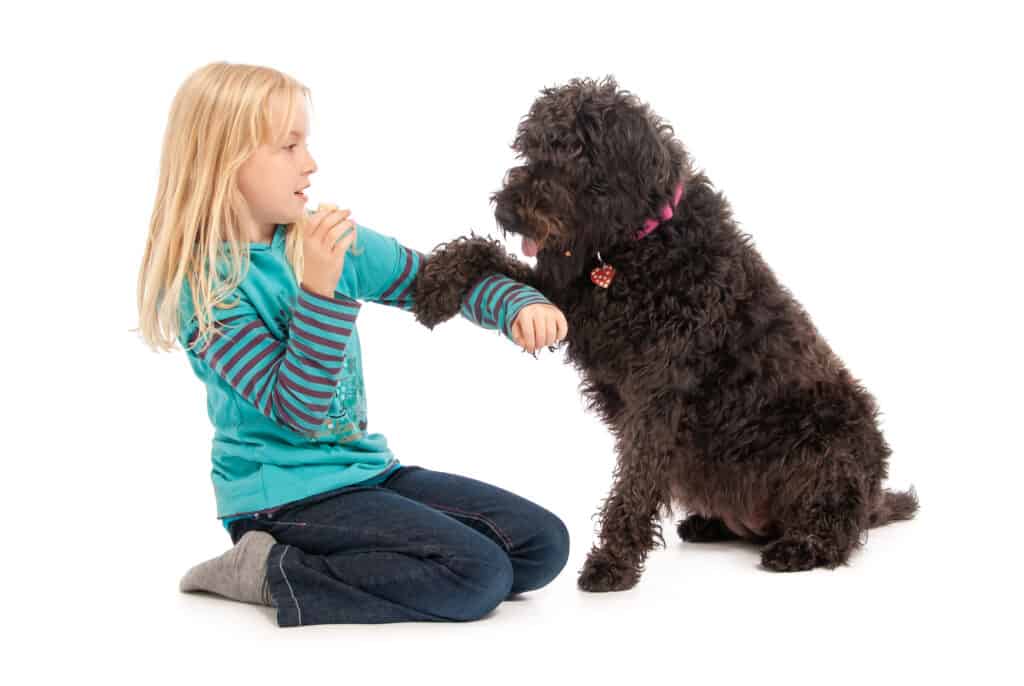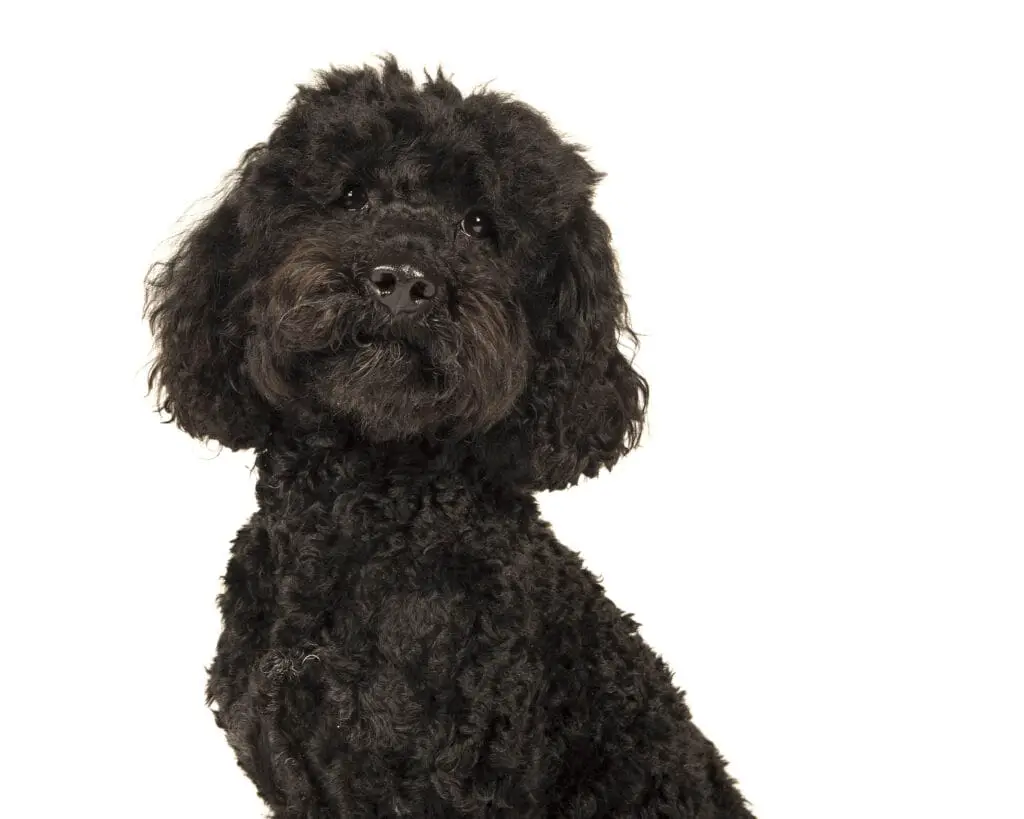Our website is supported by our users. We sometimes earn money when you click an affiliate link and make a purchase. This is at no extra cost to you and helps us to create quality content. For all that have shown us such wonderful support, we thank you from the bottom of our hearts!
The Black Labradoodle is a crossbreed between the purebred Standard Poodle and the Labrador Retriever.
This hybrid designer dog is active, intelligent, and quick-witted. They have a black coat, usually with no other markings or small flecks of white on the chest and feet.

Like all Labradoodles, a Black Labradoodle is a crossbreed dog, also known as a hybrid, designer dog, or mixed breed.
This breed is the combination of two different purebred parent breeds, resulting in a unique and lovable companion.
Black Labradoodles are known for their friendly and playful personalities, making them a popular choice for families with children and other pets.
If you’re considering adding a Black Labradoodle to your family, it’s essential to understand their characteristics and needs.
This breed requires regular exercise and mental stimulation to stay healthy and happy.
They also require frequent grooming to maintain their curly, non-shedding coat. With proper care and attention, a Black Labradoodle can make a loyal and loving addition to any household.
History

The Black Labradoodle is a crossbreed between a purebred Standard black Poodle and purebred Labrador Retrievers.
The Labradoodle was first bred in Australia in the late 1950s as a guide dog for visually impaired individuals who needed a hypoallergenic dog.
The breed was initially created by Wally Conron, who worked for the Royal Guide Dog Association of Australia.
As mentioned, the Labradoodle was created by crossing a Labrador Retriever with a Standard Poodle, with the hope of producing a dog with the intelligence and trainability of the Poodle and the friendly and loyal nature of the Labrador Retriever.
The breed quickly gained popularity in Australia and was soon exported to other countries, including the United States.
The Australian Labradoodle Association was formed in 2004 to promote the breeding of Labradoodles in Australia. The association sets standards for breeding practices and ensures that Labradoodles are bred responsibly.
Today, the Labradoodle is considered a designer dog and is a popular choice for families looking for a low-shedding dog.
Since they are a designer dog, they are not recognized by the American Kennel Club. They are, however, recognized by the Designer Kennel Club.
The breed is also used as a service dog due to its intelligence and trainability.
However, it should be noted that not all Labradoodles are hypoallergenic, as this trait can vary depending on the individual dog’s genetics.
Overall, the Labradoodle has a relatively short history compared to other dog breeds, but it has quickly become a beloved companion for many families.
Physical Characteristics of the Standard Poodle
The Standard Poodle is a breed of dog that is known for its elegant appearance and distinctive coat.
They are a medium to large-sized dog, standing at around 15 inches to over 20 inches tall at the shoulder and weighing between 45 and 70 pounds.
They have a long, narrow muzzle and a head that is proportionate to the rest of their body.
One of the most noticeable physical characteristics of the Standard Poodle is their ears.
They have long floppy ears that hang down close to their head. Their ears are covered in long, curly hair, which adds to their distinctive appearance.
Another feature of the Standard Poodle is their long tail.
They have a straight tail that is set high on their body. When they are relaxed, their tail hangs down, but when they are excited or alert, they hold their tail up high.
The coat of the Standard Poodle is also a defining characteristic of the breed.
They have a dense, curly coat that is hypoallergenic, which makes them a popular choice for people with allergies.
Their coat can come in a variety of colors, including black, white, brown, and gray.
Overall, the Standard Poodle is a well-proportioned dog with a regal appearance and a distinctive coat.
Their long ears, straight tail, and curly coat all contribute to their unique appearance, making them a popular choice for dog lovers around the world.
Physical Characteristics of the Labrador Retriever
The Labrador Retriever is a medium to large-sized breed with a muscular and athletic build.
They have a broad head, short and dense low-shedding coat, and a powerful neck.
This breed typically weighs between 55-80 pounds and stands 21.5-24.5 inches tall at the shoulder.
One of the most distinguishing features of the Labrador Retriever is their floppy ears, which hang down close to their head.
Their ears are medium-sized, triangular in shape, and set well apart. They are covered with short, dense hair that matches the color of the dog’s coat.
Another defining characteristic of the Labrador Retriever is their long and thick tail.
Their tail is usually described as an “otter tail” due to its shape and is covered in dense fur. The tail is used by the dog as a rudder when swimming, and it also helps to balance the dog when running.
Labrador Retrievers come in different colors, including chocolate, yellow, and black coat color.
The black Labrador Retriever is one of the most popular colors and is known for their shiny and sleek coat.
They have a solid black coat with no other markings or small flecks of white on the chest and feet.
In summary, the Labrador Retriever is a medium to large-sized breed with a muscular build, floppy ears, a long and thick tail, and a short and dense coat.
The black Labrador Retriever is known for their solid black coat and shiny appearance.

Black Labradoodles can be a genetic mix of any of the above but the obviously have a black color (sometimes with a bit of white markings), with black noses and brown eyes.
The Labradoodle coats can come in a variety of colors spanning all of the colors of the Poodle and all of the colors of the Labrador Retriever.
Labradoodle colors include:
Chocolate Labradoodles
Silver Labradoodles
Red Labradoodle
Parti Labradoodles
Apricot Labradoodles
Cream Labradoodle
Blue Labradoodles
Golden Labradoodle
Phantom Labradoodle (a solid color with tan points).
Temperament & Training
Black Labradoodles are known for their friendly, intelligent, and playful temperament making them a wonderful family member.
They are a popular companion dog and are great for families with young children.
However, like all dogs, they require socialization and mental stimulation to keep them happy and healthy.
Training is also essential for a Black Labradoodle.
They are energetic and eager to please, making them easy to train using positive reinforcement techniques. Obedience training is recommended to ensure they are well-behaved and obedient in all situations.

In addition to obedience training, Black Labradoodles excel in agility training.
Their athletic build and high energy levels make them perfect for this type of training, which provides both physical and mental stimulation.
Overall, Black Labradoodles have a great temperament and are easy to train using positive reinforcement techniques.
With proper socialization and training, they make wonderful companions for families and an excellent hypoallergenic guide dog.
Health Issues of the Standard Poodle
Standard Poodles are generally considered to be a healthy breed, but like all dogs, they can be prone to certain health conditions.
Some of the most common health concerns seen in Standard Poodles include hip dysplasia, elbow dysplasia, progressive retinal atrophy, and epilepsy.
Hip & Elbow Dysplasia
Hip dysplasia is a genetic condition that affects the hip joint and can lead to arthritis and lameness.
Elbow dysplasia is another genetic condition that affects the elbow joint and can cause lameness and pain.
Both conditions can be diagnosed with X-rays and treated with medication, surgery, or a combination of both.
Progressive Retinal Atrophy
Progressive Retinal Atrophy is a genetic condition that affects the retina of the eye and can lead to blindness.
Symptoms of this condition include night blindness, dilated pupils, and a loss of peripheral vision.
There is no cure for progressive retinal atrophy, but the progression of the disease can be slowed with medication and special diets.
Epilepsy
Epilepsy is a neurological disorder that can cause seizures in dogs.
The cause of epilepsy is not fully understood, but it is believed to be a combination of genetic and environmental factors.
Treatment for epilepsy includes medication and management of triggers that can cause seizures.
Skin Conditions
Standard Poodles are also prone to certain skin conditions, including allergies and sebaceous adenitis.
Allergies can cause itching, rashes, and hair loss, while sebaceous adenitis can cause scaly, flaky skin and hair loss. Treatment for these conditions typically involves medication and special diets.
Overall, it is important to keep up with regular veterinary check-ups and to be aware of any changes in your Standard Poodle’s behavior or health.
By staying informed and proactive, you can help your dog live a long and healthy life.
Health Issues of the Labrador Retriever
Like any other dog breed, Labradors are prone to certain health issues.
These issues can be genetic or acquired.
Some of the most common health issues in Labradors include hip dysplasia, elbow dysplasia, progressive retinal atrophy, and epilepsy.
Hip & Elbow Dysplasia
Hip dysplasia is a genetic condition that affects the hip joint. It is caused by an abnormal development of the hip joint, which can lead to arthritis and pain.
Labradors are prone to hip dysplasia, and it can cause lameness and difficulty in moving around.
Elbow dysplasia is another genetic condition that affects the elbow joint. It is caused by an abnormal development of the elbow joint, which can lead to arthritis and pain.
Labradors are prone to elbow dysplasia, and it can cause lameness and difficulty in moving around.
Progressive Retinal Atrophy
Progressive retinal atrophy is a genetic condition that affects the eyes. It is caused by a degeneration of the retina, which can lead to blindness.
Labradors are prone to progressive retinal atrophy, and it can cause vision loss and blindness.
Epilepsy
Epilepsy is a neurological condition that affects the brain. It is caused by abnormal electrical activity in the brain, which can lead to seizures.
Labradors are prone to epilepsy, and it can cause seizures and other neurological symptoms.
It is important to note that not all Labradors will develop these health issues, but it is important to be aware of them.
Regular check-ups with a veterinarian can help detect these issues early on and provide appropriate treatment.
With the merging of two dogs with such similar health issues, it has to be said that it increases the likelihood of your dog having them as well.
Grooming Your Black Labradoodle
Black Labradoodles are a low-shedding and hypoallergenic breed that require regular grooming to maintain their coat and overall health. Here are some tips for grooming your black Labradoodle:
Brushing the Wavy or Fleece fur of the Black Labradoodle
Brushing your black Labradoodle’s fur is important to prevent matting and tangling.
Use a slicker brush or a comb to brush the fur in the direction of growth, starting from the head and moving towards the tail.
Brushing should be done at least once a week for wavy or fleece coat types.
Related Article:
Best Dog Brushes for Short Hair
Bathing the Wavy or Fleece fur of the Black Labradoodle
Bathing your black Labradoodle should be done every six to eight weeks or as needed.
Use a mild dog shampoo like this Oatmeal Dog Shampoo & Conditioner and warm water to wet the fur and lather the shampoo.
Rinse the fur thoroughly and dry with a towel or a hairdryer on a low setting.
Check out our article on shampoos for dogs with itchy skin.
This ELEGX Pet Grooming Bath Massager can gently get down to the skin of your dog to throughly clean their skin and give them a gentle massage.
Cutting Wavy or Fleece fur of the Black Labradoodle
Trimming your black Labradoodle’s fur is necessary to maintain a neat appearance and prevent matting.
Use scissors or clippers to trim the fur to the desired length, keeping the fur short around the eyes, ears, and paws.
Clipping or Grinding Nails
Trimming your black Labradoodle’s nails is important to prevent overgrowth and discomfort. Use a clipper or a grinder to trim the nails, being careful not to cut the quick.
If you are unsure, consult a professional groomer or veterinarian.
Grinding the nails with a pet nail grinder is a safer option, especially for inexperienced pet owners.
To stop bleeding if you unintentionally cut the quick, use styptic powder in order to stop the bleeding.
Just dip the nail into the powder and it will usually stop on the first try.
Additionally, take a look at our articles on How to Grind Your Dog’s Nails and How to Clip Your Dog’s Nails.
To find the best grinder, check out this article on choosing a grinder.
Dental care
Dental care is important to prevent dental disease and bad breath. Brush your black Labradoodle’s teeth with a dog toothbrush and toothpaste at least twice a week.
Provide dental chews or toys to help clean their teeth.
Cleaning Ears
Cleaning your Labradoodle’s ears is important to prevent infection and discomfort. Use a damp cloth or a cotton ball to clean the outer ear, being careful not to insert anything into the ear canal.
These Pet MD cleaning wipes can make the job easier.
If you notice any signs of infection, consult a veterinarian.
In summary, grooming your black Labradoodle is essential to maintain their hypoallergenic coat and overall health.
Regular brushing, bathing, trimming, nail clipping, dental care, and ear cleaning are necessary to keep your black Labradoodle looking and feeling their best.
Owning a Black Labradoodle
If you’re considering owning a Black Labradoodle, there are a few things you should know.
Black Labradoodles are a crossbreed between the purebred Standard Poodle and the Labrador Retriever.
They have a black coat, usually with no other markings or small flecks of white on the chest and feet.
Shedding and Maintenance
One of the benefits of owning a Black Labradoodle is that they are hypoallergenic and don’t shed much.
However, they still require regular grooming and maintenance to keep their curly coat in good condition.
This includes brushing, trimming, and occasional bathing.
Exercise and Attention
Black Labradoodles are an athletic breed that requires regular exercise and attention.
They are intelligent and quick-witted, which means they need mental stimulation as well as physical exercise.
Daily walks, playtime, and training sessions can help keep them happy and healthy.

Loyal and Affectionate
Black Labradoodles are known for their loyalty and affection towards their owners.
They are great family pets and get along well with children and other pets.
They have a loving and gentle nature that makes them great therapy and service dogs.
Weight and Lifespan
The weight of a Black Labradoodle can range from 55 to 65 pounds, depending on their size and build.
Their lifespan is typically between 12 to 15 years.
Finding a Breeder or Rescue
If you’re interested in owning a Black Labradoodle puppy, you can find reputable breeders or rescue organizations online.
It’s important to do your research and choose a breeder or rescue that is reputable and follows ethical breeding practices.
When you know your breeder is ethical, you can be assured that you avoided puppy mills that churn out sick black labradoodle puppies.

Overall, owning a Black Labradoodle can be a rewarding experience for families and individuals who are looking for a loving and loyal companion.
With proper care and attention, they can make great family pets, therapy dogs, and service dogs.
The black Labradoodle can look similar to a black Goldendoodle depending on the genetic makeup of the dog.
So if you are set on owning a Labradoodle then you will want to make sure you use a reputable breeder and have some genetic testing done.
Conclusion

In conclusion, the Black Labradoodle is an intelligent, affectionate, and playful breed that makes an excellent companion for active families.
With their charming personality and striking features, it’s no wonder that they have become a popular choice for many would-be pet parents.
One of the most notable characteristics of the Black Labradoodle is their fluffy coat, which can come in a variety of colors, including black, white, and chocolate.
While their coat may require some grooming, it is well worth the effort for the joy and companionship they bring.
Black Labradoodles are also known for their high energy levels, which make them ideal for families with children or active individuals.
They are highly trainable and excel in a variety of roles, including as service dogs and therapy dogs.
Overall, the Black Labradoodle is a wonderful breed that brings joy and happiness to the lives of those who choose to adopt them.
With their intelligence, affectionate nature, and charming personality, they are sure to make a great addition to any family.
Frequently Asked Questions

What is the personality of a Labradoodle?
Labradoodles are known for their friendly and outgoing personalities. They are intelligent, loyal, and affectionate dogs that make great family pets.
Labradoodles are also highly trainable and excel in various activities such as agility, obedience, and therapy work.
They are social animals and enjoy spending time with their owners and other pets.
Are black Labradoodles good dogs?
Black Labradoodles are excellent dogs that make great companions.
They are intelligent, affectionate, and loyal to their owners.
They are also highly trainable and excel in various activities such as agility, obedience, and therapy work.
Black Labradoodles are hypoallergenic and do not shed much, making them ideal pets for people with allergies.
What is the rarest color for a Labradoodle?
The rarest color for a Labradoodle is generally considered to be red. Other rare colors include cream, apricot, and chocolate.
Black Labradoodles are not considered rare, but they are still highly sought after due to their beautiful and sleek appearance.
What is the lifespan of a black Labradoodle?
The lifespan of a black Labradoodle is generally between 12 and 15 years.
However, the lifespan can vary depending on various factors such as genetics, diet, exercise, and overall health.
Proper care and regular veterinary checkups can help ensure that your black Labradoodle lives a long and healthy life.
Is it common to find black Labradoodles in rescue?
It is not uncommon to find black Labradoodles in rescue.
Many Labradoodles end up in rescue due to their owners’ inability to care for them properly.
Adopting a rescue Labradoodle can be a great way to give a loving home to a dog in need.
However, it is important to do your research and ensure that you are prepared to provide the necessary care and attention to your new pet.
Please read our Legal Disclaimer








